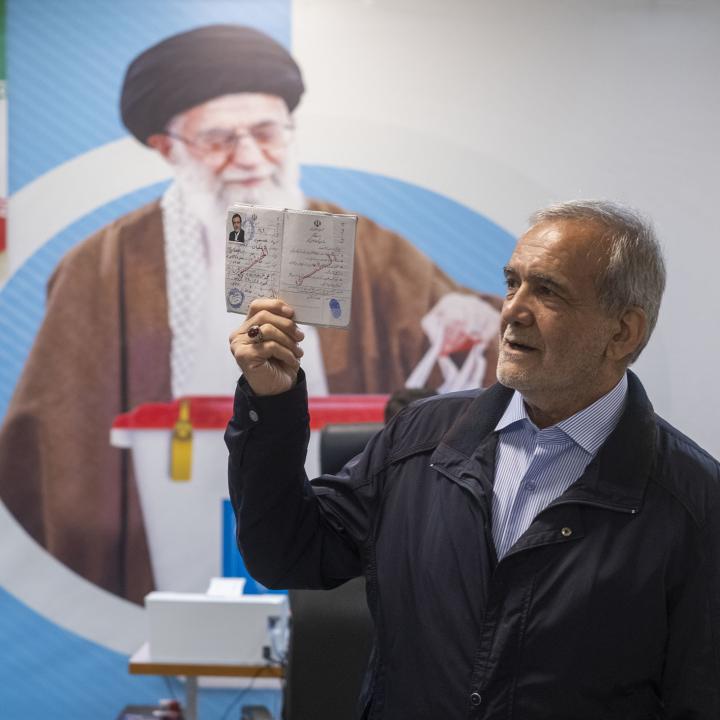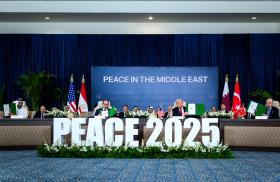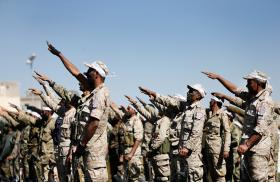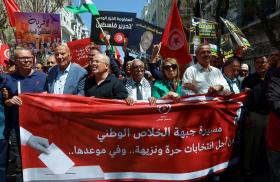
- Policy Analysis
- PolicyWatch 4034
Pragmatists Open a Window in Tehran—But for How Long?

Regime officials and the Supreme Leader himself have signaled a willingness to make unprecedented concessions, but taking advantage of this opening will require careful U.S. messaging on counterterrorism, regional deterrence, and human rights.
Confronted by regional losses, a deepening economic crisis, and simmering domestic upheaval, the Islamic Republic has been making unusual concessions internally and externally that challenge its founding revolutionary identity. Long defined by its defiance of the international order, Tehran is now signaling openness to negotiations, economic engagement, and even American investment. These shifts reflect existential fear rather than a desire for reform. As hardliners grow increasingly alienated and more pragmatic figures gain influence, the regime’s internal balance is shifting, at least for now. How the international community responds could determine whether this development opens space for longer-term transformation or simply helps the hardliners stay in power.
Foreign Policy Concessions
Supreme Leader Ali Khamenei expressed cautious satisfaction with the first round of U.S. nuclear talks that took place in Oman last month—a drastic shift from his position in February, when he asserted that negotiating with Washington was neither wise nor honorable. Other officials have gone further, appearing to relinquish ideological principles that the regime zealously upheld for decades.
For instance, President Masoud Pezeshkian recently stated that the Supreme Leader “has no opposition to American investors,” and Khamenei’s office did not deny the remark. In practical terms, such economic relations would require restoring diplomatic ties that have been severed for forty-five years, not to mention departing from Khamenei’s longstanding warning that Iran will resist any American economic or political infiltration with full force.
The regime has failed to back up its aggressive rhetoric on other bilateral matters as well. For example, after a U.S. strike killed Iranian general Qasem Soleimani in January 2020, Khamenei vowed enteqam-e sakht (“severe revenge”) against those responsible, including President Trump himself. Despite foiled assassination plots, limited military responses, and other Iranian actions since then, this threat has largely gone unfulfilled. Five years later, the regime is now negotiating with the very actors it once swore to annihilate. Similarly, following Israeli strikes on Iranian targets last October, Tehran pledged retaliation under “Operation True Promise III” but never actually launched further attacks.
Domestic Retreat
In the past, the Islamic Republic would often compensate for any ideological concessions it made abroad with heightened repression at home, cracking down on dissent to project strength, deter opposition, and reassure its hardline base. Today, however, it appears increasingly constrained domestically, fearing that further crackdowns could spark a larger wave of unrest and force it to offer even wider domestic concessions.
Accordingly, the regime’s (admittedly inconsistent) domestic approach has shown signs of eased enforcement on some personal freedoms, and events that were once tightly controlled are now taking place with less interference (e.g., cultural and music festivals). The hardline minority continues to call for stricter oversight, particularly on public morality issues, but the regime is seemingly prioritizing broader public sentiment.
Tehran also appears to be loosening its grip on freedom of expression. Persian-language social media outlets are now replete with videos—many of them produced inside Iran—featuring experts, activists, and former officials openly discussing topics once considered taboo, including visions for a post-Islamic Republic political system and even the “political death” of Khamenei himself. Although such discourse occasionally generates backlash, its growing visibility signals a tentative shift in the boundaries of public debate.
The regime’s most consequential concession relates to compulsory wearing of the hijab. Officials have essentially ceded ground to the majority of Iranian women who oppose these rules. Despite the government introducing new measures to monitor hijab compliance, many women in major cities continue to openly defy them, and authorities have stopped short of fully enforcing the restrictions. When hardliners protested outside parliament in March to demand that hijab laws be enforced, police dispersed them—an unusual move that signaled the regime’s fear of reigniting the 2022 “Woman, Life, Freedom” uprising. This concern was especially evident in Khamenei’s Eid al-Fitr sermon in late March, when he downplayed the likelihood of an Israeli or U.S. military attack on Iran but appeared to acknowledge the possibility of a domestic uprising (though he made sure to claim that such “sedition” could only be incited by foreign enemies).
Cracks in the Ideological Core?
The regime’s willingness to compromise under pressure is hardly new, but previous instances were more limited and less overt, particularly at the very top of the leadership chain. In September 2013, Khamenei paved the way for the talks that led to the 2015 nuclear deal by introducing the term narmesh-e qahremananeh (“heroic flexibility”) into Iran’s political lexicon. This stance enabled him to give negotiators the space they needed to ease international pressure while simultaneously cautioning them against any moves that might cross the regime’s red lines or abandon its core ideals. Perhaps most important from Khamenei’s perspective, such “flexibility” allowed him to maintain rhetorical distance from the nuclear deal in the years after it was signed, insulating him from the political fallout of making concessions. Indeed, hardliners publicly blamed other officials such as President Hassan Rouhani and Foreign Minister Mohammad Javad Zarif for what they viewed as a disastrous agreement, particularly after President Trump withdrew from the deal in 2018.
Today, however, Khamenei appears to be forgoing that approach out of concern that distancing himself might embolden hardliners to sabotage the negotiations altogether. The personal risks of this new tactic are substantial, since some regime elements may conclude that the Supreme Leader is compromising or even abandoning the Islamic Republic’s ideals.
Offering concessions to safeguard the regime from existential threats is deeply rooted in the Islamic Republic’s ideology. As far back as 1983, the late Ayatollah Ruhollah Khomeini argued that “preserving the Islamic Republic is more important than preserving any one person, even if he is the Imam of the Age,” referring to the Twelfth Imam who lies at the heart of Iran’s Shia Islamic doctrine. Khomeini was able to make that argument because he equated the Islamic Republic with Islam itself.
Yet as the regime continues making deep domestic and international concessions, a fundamental question arises: to what extent can it still be considered “Islamic”? The paradox of Khomeini and Khamenei’s self-preservation principle is that it now threatens to erode the regime’s Islamic revolutionary identity and alienate its core supporters. The regime depends on this hardline minority to mobilize rallies, deliver votes when needed, suppress opposition protests, and staff key security roles, but it appears increasingly willing to frustrate them. For example, hardline politician Vahid Yaminpour warned in 2022 that if the regime abandons strict religious enforcement, the loyal base would be the first to “disembark.”
A Potential Terrorist Relief Valve
To manage this growing internal risk, Tehran will likely rely even more on asymmetric armed action abroad as a pressure relief valve at home. By conducting limited, low-cost attacks against “softer” foreign targets, the regime could seek to manufacture symbolic victories that appease its hardline base without jeopardizing foreign negotiations or provoking large-scale domestic unrest. These operations might include proxy militia strikes against the Gulf states as well as plots against Iranian opposition elements abroad, Jewish organizations, Israeli civilians, or Western politicians critical of the regime. This dynamic may already be playing out: last weekend, seven Iranian nationals were arrested in the United Kingdom during a major counterterrorism sweep.
To carry out such operations, Iran could use regime-affiliated citizens who reside in the West along with its main regional proxies, namely, Iraqi Shia militias, Lebanese Hezbollah, and the Yemeni Houthis. Alternatively, it could leverage transnational criminal networks, friendly al-Qaeda elements, or militia affiliates in Africa, thereby maintaining plausible deniability while still signaling strength. Deterring and constraining such asymmetric escalation will be critical—otherwise, armed action abroad could strengthen hardliners in Iran, derail Tehran’s tentative domestic shift, and slam the door on its current opening to Washington.
Policy Recommendations
There are growing signs that elements within the very core of the Iranian regime favor a version of the Islamic Republic that preserves its outer shell while shedding its most radical ideological foundations. Although Khamenei has traditionally aligned with hardliners, recent developments suggest that more pragmatic voices may now have his ear, promoting normalization with neighbors and the international community as essential to regime survival. To preserve this fragile opening, the United States and its partners should do the following:
Enforce red lines on violence. Washington must make clear that any Iran-backed terrorist or proxy attacks abroad—including low-cost strikes on soft targets—will trigger immediate consequences such as suspended negotiations and new sanctions. In addition to deterring further aggression, this approach could help deny hardliners the symbolic victories they need to maintain influence. While hardliners may prefer to collapse talks with the United States, regime leaders are unlikely to risk the resultant isolation if they conclude that the Islamic Republic’s survival depends on normalization. Presenting Tehran with a believable threat of meaningful consequences is therefore essential.
Maintain credible deterrence. The United States has already taken steps to rebuild deterrence, as shown in its recent military deployments to the region and use of force against the Houthis. Yet sustaining and sharpening this posture is critical. Washington should continue signaling that military options remain on the table in the event of large-scale Iranian-sponsored attacks on U.S. allies or terrorist operations in the West. This includes clarifying the red lines that would trigger renewed strikes against the Houthis now that President Trump has suspended the Yemen air campaign. Such an approach would complement the current diplomatic track by reassuring regional partners, narrowing Tehran’s space for plausible deniability, and establishing a clear threshold that the regime knows not to cross.
Support emerging political pluralism in Iran. The United States should strengthen its support for nonviolent engagement and rights-based democracy programs aimed at empowering Iranian civil society, recalibrating it to fit the current moment. Although the Trump administration initially paused U.S. funding for some of these Iranian initiatives, it soon restored the assistance, at least temporarily. Amplifying Iranian voices who advocate political pluralism remains critical, but this must be done carefully to avoid undermining them. Overt U.S. endorsement can expose activists to regime accusations of foreign collaboration, damaging their domestic credibility. Instead, Washington should prioritize indirect support mechanisms (see below), multilateral initiatives through international forums, and discreet diplomatic engagement that elevates universal rights without overt American branding. Expanding Track II dialogue via nongovernmental actors could further open channels of communication and help amplify and support Iranian voices with less risk of regime backlash. At a time when public opposition is rising and the regime’s ideological foundations are cracking, discreetly backing values such as women’s rights, freedom of expression, and legal accountability could embolden pragmatic regime actors and broaden the space for future political transition.
Hamdi Malik is an associate fellow with The Washington Institute and cofounder of its Militia Spotlight platform.


